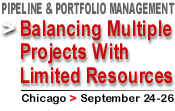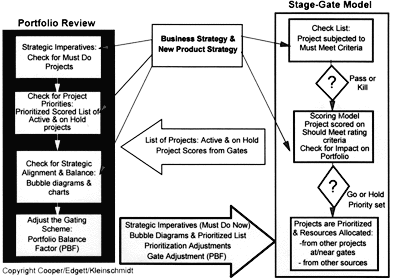 
 Download Brochure
Download Brochure
(PPM2001.pdf - 641 kb)
|
|
Keynote Presentations
"Another success by MRT, exceeded expectations
thoroughly...creme de la creme of speakers..."
-
Michael Kobrehel, Manager, New Product Development, Excel
Industries
Agile Project Management: Problems, Principles and Practices 
DAY ONE - Tues, Sept. 25
8:30 am – 9:45 am |
 |
Jim Highsmith
Director, e-Project Management Practice
Cutter Consortium |
|
Those who view the dot-com
debacle as vindicating a return to traditional modes of
operation are in for a wicked surprise. The turbulence, change,
and uncertainty of our New Economy preceded the dot-coms, and it
will linger on and intensify as leading companies continue their
competitive drive towards an e-business and e-commerce future.
But as the dials are turned up on change and uncertainty,
traditional project management practices are showing the strains
of age. Enter today’s "Agile Methodologies*," particularly those
in the all-important software and information technology
arena—Extreme Programming, Lean Development, Scrum, Crystal
Methods, and Adaptive Software Development—are gaining
recognition. Why? What Problems are these Agile
Methodologies solving? What key Principles, if any, are
common among the various approaches? Finally, how do
organizations navigate among Agile Methodology Practices?
This presentation, geared to understanding the Problems,
Principles, and Practices of Agile Methodologies will help
practitioners explain the benefits of these approaches to both
customers and management and assist them in adapting and scaling
them to a diverse set of e-business projects.
Jim Highsmith
is director of the Cutter Consortium’s e-Project Management
Practice and author of Adaptive Software Development: A
Collaborative Approach to Managing Complex Systems which
recently won Software Development magazine’s prestigious JOLT
award for product excellence. He has 30 years experience as a
consultant, software developer, manager, and writer. Jim has
published dozens of articles in major industry publications and
his ideas about project management in the Internet era have been
featured in ComputerWorld in the U.S. and The Economic Times in
India. In the last ten years, he has worked with both IT
organizations and software companies in the US, Europe, Canada,
South Africa, India, Australia, Japan, and New Zealand to help
them adapt to the accelerated pace of development in
increasingly complex, uncertain environments.
* While derived from the software
world, agile project management applies to all
product development in a high-speed, high-change environment.
Strategic Portfolio Management: Leveraging Your Pipeline 
DAY ONE - Tues, Sept. 25
4:30 pm – 5:30 pm |
 |
Dr. Scott Edgett
CEO and co-founder,
Product Development Institute |
|
What are the key drivers
for successfully managing a NPD portfolio? How are leading
organizations dealing with this issue? In this presentation, Dr.
Scott Edgett will provide insights into how companies are using
portfolio management to:
- Allocate resources to maximize the value of the portfolio
(e.g., long term profitability; or ROI)
- Achieve a desired balance of
projects across competing demands; for example:
- between long term & short, fast projects
- between high risk and low risk
- across various markets
- across different technologies (e.g. embryonic, pacing,
base)
- across different types of innovation: new products,
improvements, cost reductions, fundamental research
- Obtain the right number of projects for your pipeline
- balancing resource demands with resource availability
- Linking the new product effort to the Business Strategy
ensuring that projects are "on strategy":
- that spending on projects reflects the strategic
priorities of the business
- that the business strategy will be realized via the list
of active projects
Dr. Scott J. Edgett is
an internationally recognized expert in the field of new product
development and portfolio management. He is CEO and co-founder
of the Product Development Institute and an Associate Professor
of Marketing at the Michael G. DeGroote School of Business,
McMaster University, Ontario, Canada. Scott is also on the Board
of Directors for the Product Development Management Association
and Vice President of Publications.

Product Development
Multi-Project Management 
DAY TWO - Wed, Sept. 26
8:00 am – 9:30 am |
 |
Michael Cusumano
Professor
MIT/Sloan |
|
How do you manage product
development more strategically and efficiently? Learn how
multi-project management can leverage projects and bring
enormous benefit to companies. The basic idea is to create new
products that share key components but utilize separate
development teams to ensure that each product differs enough to
attract different customers. If possible, projects that share
components and engineering teams should overlap in time so that
a firm can deliver many products quickly and utilize very new
technologies. The evidence suggests that, if they follow these
principles, firms can achieve dramatic improvements in
performance – huge savings in development costs (engineering
hours) as well as remarkable growth in sales and market share.
The examples and data are mainly from the automobile industry.
The ideas, however, apply to many companies that have more than
one product and want to expand the number of new products
rapidly and efficiently.
Michael A. Cusumano,
MIT Sloan Professor
and noted author (Competing on Internet Time: Lessons from
Netscape and its Battle with Microsoft, Microsoft Secrets,
Thinking Beyond Lean: How Multi-Project Management is
Transforming Product Development at Toyota and Other Companies,
etc.) specializes in strategy and technology management in the
computer software, automobile, and consumer electronics
industries. |
|

